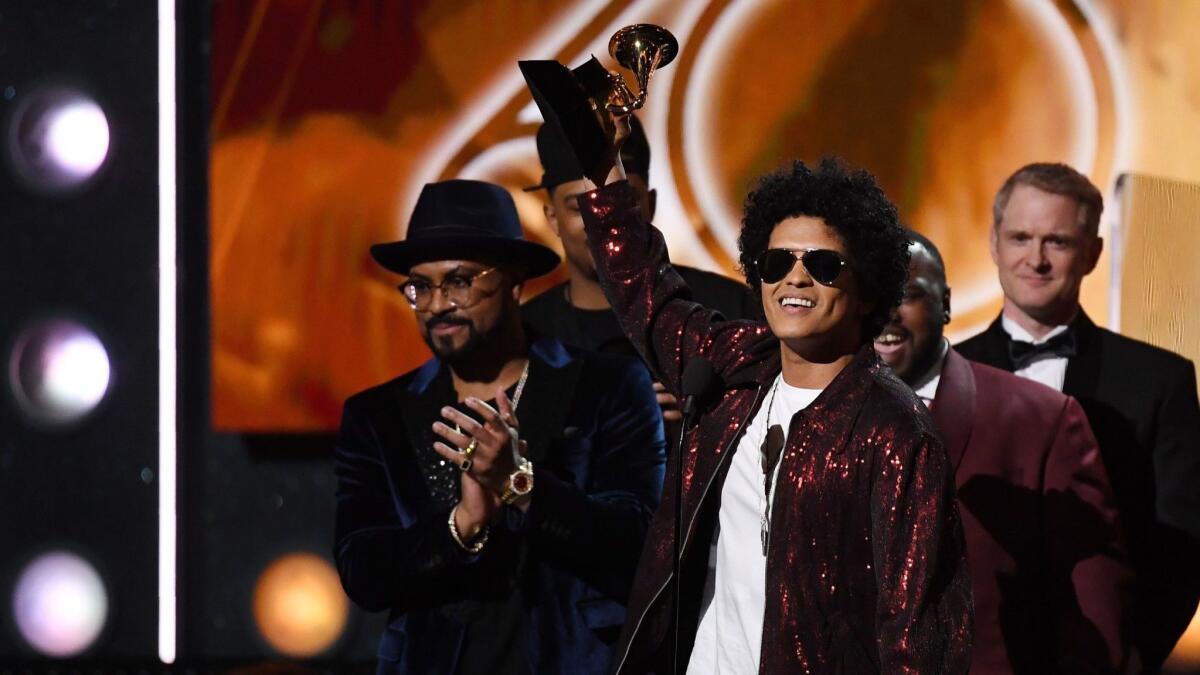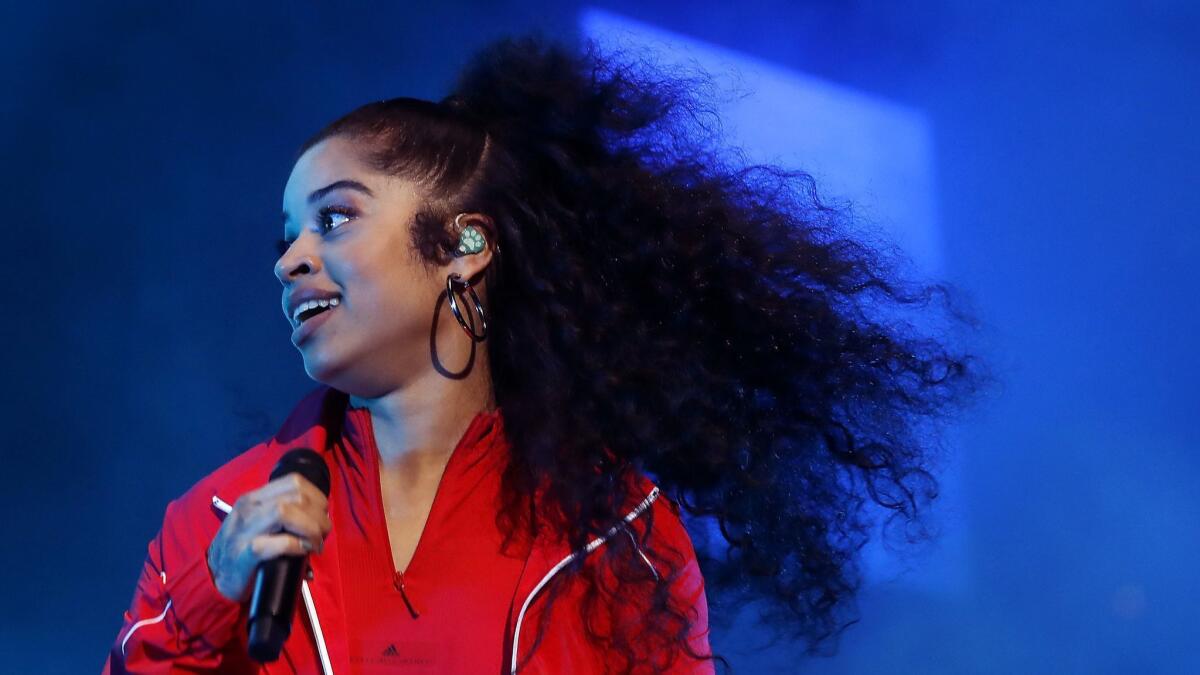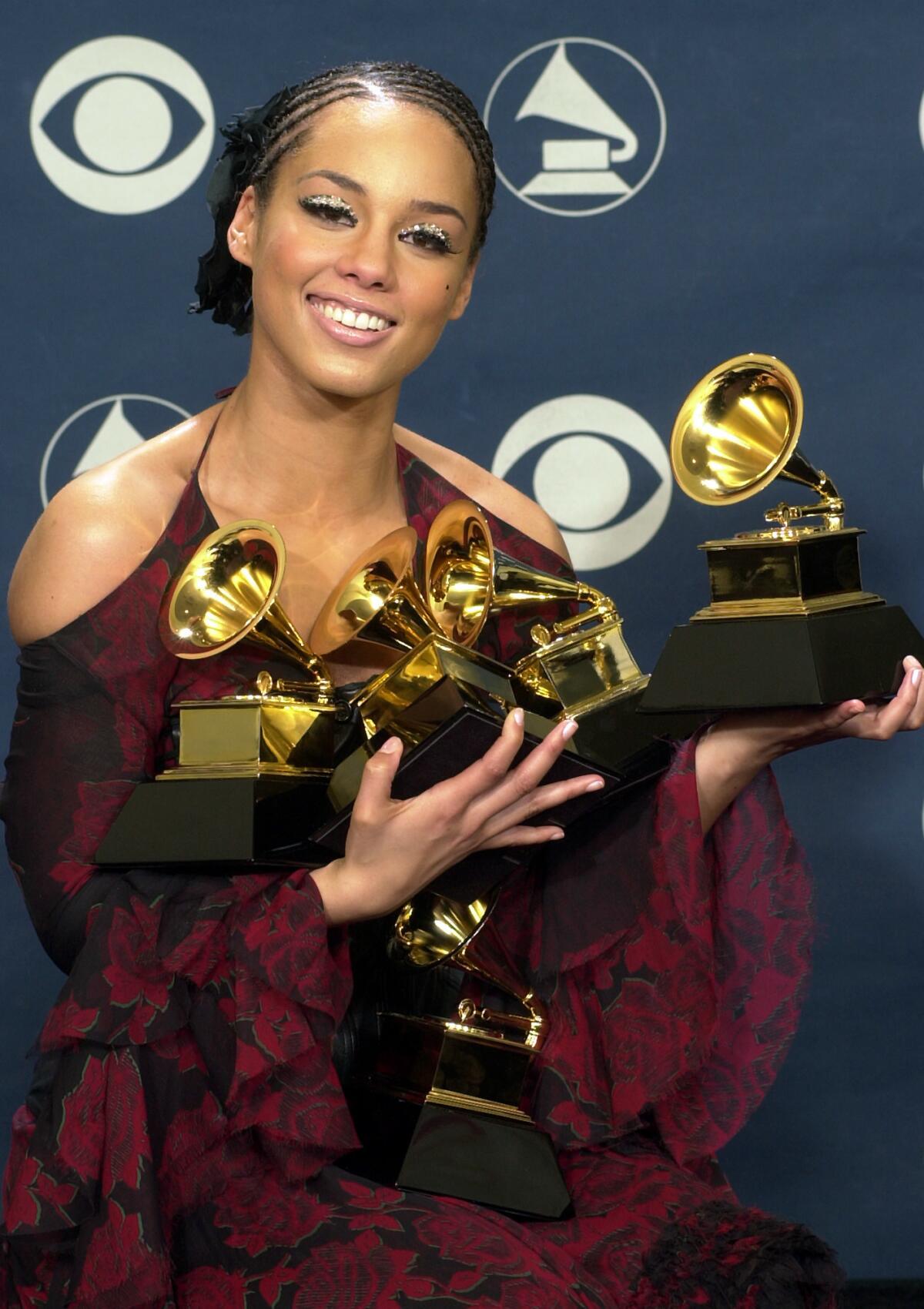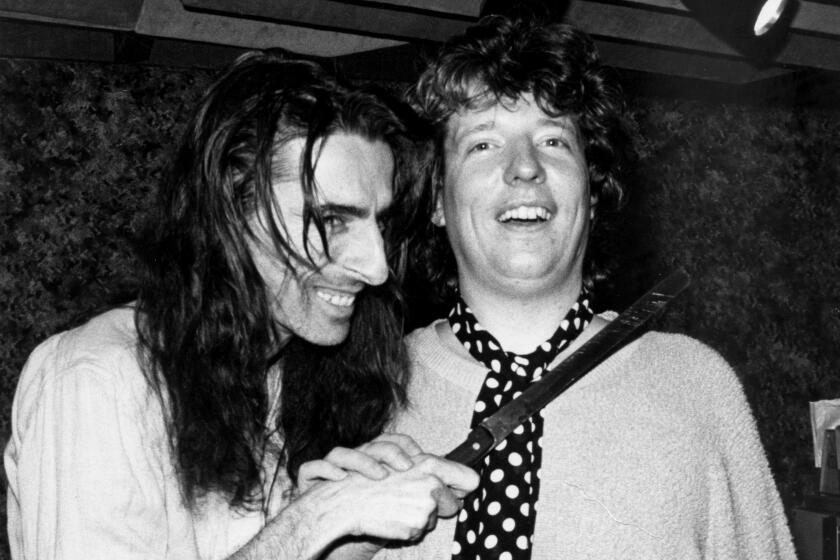‘Real R&B’ seemed like a lost art. Fresh voices have changed that — but is it enough?

- Share via
At this year’s Grammy Awards in February, the narrative was tightly focused on rap’s prominence among nominees in the major categories after historically being overlooked.
So when Bruno Mars, one of the most successful pop stars on the planet, bested Kendrick Lamar in every major race, the Grammys were once again seen as favoring commercial acclaim above the rest.
Excluded from the conversation, though, was the fact that Mars had cleaned up with an album of modern new jack swing — a subgenre of contemporary R&B innovated in the late 1980s that connected soul and funk with hip-hop beats.
And such is the story of R&B. Always prevalent, yet often forgotten despite the continued rise of melodic, R&B-infused hip-hop and pop on the charts, on radio and on streaming services.
Yet between Mars’ sweep at the Grammys and an influx of young fresh faces — Ella Mai, H.E.R., Daniel Caesar, Jorja Smith and Queen Naija to name a few — this has been a year in which R&B is a central part of the pop conversation.
“Hip-hop has made this impact. People want to have fun and turn up — but people also want to hear raw, genuine emotions,” says rising R&B artist H.E.R. “I think that's why I've cut through and that's why there’s a surge of R&B artists cutting through. … We are seeing all of these artists staying true to themselves and showing the record labels that R&B has not died. People are gravitating toward the music that reminds them of Brandy, Monica and SWV that made ’90s R&B so special. It’s like real R&B is coming back.”
For the artists, songwriters and producers trying to make a living in R&B, however, they still must contend with fewer platforms for exposure, hip-hop’s homogenization of radio and a widening generational divide. Despite its mainstream comeback, R&B remains at a crossroads.
A golden age ends
“For a while, R&B itself was almost like a bad word,” says multiplatinum hitmaker Claude Kelly. “There was a purposeful move from the urban R&B community to go to pop, rap, EDM or whatever else because that was making more money. In essence, the genre was abandoned.”
This wasn’t always the case. For decades, its influence was indelible — particularly during the ’90s, an era often referred to as R&B’s golden age. Artists dominated the charts, and an explosion of groups saw a wave of diverse faces and voices crossing over to the pop charts.
R&B also set the pace for hip-hop’s ascent to prominence as its artists leaned on the defining sounds of the genres — from lush soul melodies to jazz-infused grooves — to provide a crucial framework for rap records via sampling or getting singers on the hook.
“I remember when R&B singers sang the song and the rappers did a hook. Now singers are just doing the hooks. And, actually, some rappers are doing the songs and the hooks,” R&B star Tamia says with a laugh.
Hip-hop’s increasing cultural dominance eventually eclipsed rhythm and blues, and many raced to keep up to the point where modern R&B was impossible to differentiate from rap as hip-hop’s pummeling sound became preferred over soft balladry, crescendo bridges and complex melodies. In response, artists increasingly moved toward harder sounds and dance beats in order to cross over.
But where R&B artists have really felt the pinch is record sales and radio play.
Getting signed to a major label, radio airplay, music videos, touring, endorsement deals (if you’re lucky) — that’s how things worked before the advent of digital downloading nearly 20 years ago and streaming a decade later.
No genre has embraced the digital era as fully as hip-hop, with its artists leveraging digital streaming and online distribution platforms like Spotify and SoundCloud to get their music directly to listeners.
And no genre had been as dependent upon that old industry ecosystem as R&B.
For a while, R&B itself was almost like a bad word. ... In essence, the genre was abandoned.
— Claude Kelly

In recent years, that reliance has shifted by necessity. Album sales have evaporated and, with urban radio dominated by rap and pop, R&B artists have had to learn to pivot in what has become a young person’s game.
What really hurt was physical CDs losing their power as big box stores such as Target and Best Buy reduced or abandoned CD displays. A revived interest in the pop and hiss of vinyl has been a way to lure fans back into physical album buying and collecting — but that too is largely driven by millennials.
As rap artists and labels quickly leveraged the growth of digital streaming services, R&B was slower to adapt — and this includes a generation of core listeners also grappling with adopting new technology.
“The demise of physical retail and the shift to streaming put R&B in a really bad position,” says Alan Grunblatt, president of urban and rock at Entertainment One. “An R&B album that was selling 150,000 copies its first week is now selling 50,000. The R&B consumer is still a physical consumer, and the transition has truly shifted the marketplace.
“It used to be every Tuesday people would go to Best Buy or Walmart or Target to get the latest release. When stores stopped giving shelf space to CDs, it destroyed that consumer behavior,” Grunblatt continues. “Not everyone is that comfortable with streaming or downloading music.”
The radio problem
The effects of R&B’s digital disruption became far more apparent as streaming figures became a key factor in an artist’s sales and chart placement. Services like Apple Music and Tidal brokered exclusivity deals for releases and have, in a sense, become record labels. Sales figures are now measured differently, allowing artists who once thrived only online to land on charts, and it forced radio to fall in line if it wants to remain relevant with listeners. Streaming’s popularity even pushed an institution as unmalleable as the Recording Academy to rethink Grammy eligibility rules.
Mainstream radio, however, remains a different beast — one that has grown increasingly biased against R&B acts since rap infiltrated its airwaves in the early 1990s.
Last year, Nielsen Music announced that for the first time in history R&B and hip-hop represented the most consumed genres of music — after combining album sales and streaming figures — outpacing rock and pop combined.
And while it was true that urban music (a catchall signifier for black music) was dominating on the charts and is some of the most popular music in the country, its artists continue to be virtually nonexistent on pop radio, which reaches the largest audience across all formats. In fact, according to a survey Billboard released earlier this year, the volume of R&B and hip-hop songs crossing over to pop radio shrank dramatically between 1993 and 2016.

Less exposure on pop radio has left artists relegated to the two clearly defined avenues of black radio: urban contemporary — it caters to listeners ages 18-34 and is typically top-loaded with hip-hop — and urban adult contemporary, a format that completely eschews rap in favor of contemporary and traditional R&B and targets listeners ages 25-54.
Rap’s dominance, naturally, altered the DNA of urban contemporary. Artists knew they had a better shot at landing on urban contemporary if their records had a rap beat or featured a rapper. Urban contemporary became all about tempo and bass — the harder, the better.
“I’m constantly tracking down rappers to put them on my artists’ records so they can go to mainstream,” says Grunblatt. “Artists past a certain age can’t get there without a record that’s hip-hop leaning in order to work on R&B mainstream radio.”
It’s that continued lack of crossover success that has made R&B less profitable in the minds of label executives.
"[Labels think] particular genres of music make more money, and sponsors buy into that because of what history has shown us over the years," singer-songwriter Sevyn Streeter says. "As artists, we get discouraged. If my fans had to go through everything I’ve gone through or Tinashe has gone through to get our music out, they would give up.”
Manager Jeff Robinson, who helped launch Alicia Keys to fame over 15 years ago and currently manages rising R&B sensation H.E.R., puts it more bluntly: “The guys running the record companies, they don’t care about us. They talk about R&B like it’s nothing,” he says. “If you spend $100 to promote a pop act and you only give an R&B act $2, who you gonna hear about more?”
“Any label that is investing in R&B needs to know they have to put in the work,” adds Ericka J. Coulter, senior director of A&R at Epic Records.
R&B’s youth movement
The success of young upstarts such as Ella Mai, Daniel Caesar, Jorja Smith and H.E.R. over the past year has felt like a mighty sea change for the genre.
For much of the year, Mai’s breakout debut single “Boo’d Up” — a syrupy groove that conjured the brightness of ’90s R&B — has been a mainstay on mainstream R&B stations and led to the young British R&B star earning the longest-running No. 1 on the R&B/hip-hop airplay for a woman.
Caesar exploded on urban adult contemporary, a format catering to listeners older than the 23-year-old singer-songwriter, with last year’s slow burners “Get You” and “Best Part” before crossing over to mainstream R&B and hip-hop. And H.E.R. amassed more than 1 billion streams on digital streaming platforms before she ever landed a radio hit.
“The one thing the Ella Mai record did was make people go, ‘OK, y’all are OK with R&B coming back.’ A year ago, it didn’t feel like that … not with all the hip-hop that was going on,” Coulter says. “But that’s where we’ve gotten mixed up. We want R&B to be as huge as it was in the ’90s, and to be an R&B singer means you not only have to be comfortable in your skin but also with the work of navigating [the genre]. Not everyone is.”
A widening generational gap in R&B has exposed just how widely divided the community is.
Despite the many who are excited about R&B’s upswing, some point to the younger demographics of streaming and the changing face of urban adult contemporary as nails in the coffin for genre artists over 35 who have long relied on urban AC as the sole place they could be heard.
“The sound people are gravitating towards is very ’90’s; they just don’t want to hear it from our great leaders of that world,” says R&B star Ledisi. “There’s an ignoring of a generation. So much of the sound now is taking from our past. That’s what people are gravitating towards. But imagine if someone like Pharrell hooked up with Gladys Knight. All we do is take, and I’m exhausted by that.”
Streaming services, once feared, have become a salve as R&B artists have been edged out on the charts by hip-hop and pop acts, and digital music consumption has all but become the most powerful kingmaker when it comes to breaking artists these days.
For the past three years, digital music consumption has contributed to consecutive revenue growth in the music industry, with the U.S. standing as the most crucial market, accounting for nearly 40% of global recorded revenue. As part of its sweeping survey on streaming last year, Midi Research found that 54% of streaming listeners lean on curated playlists instead of full-on albums to consume music — a stat that’s especially notable for market leader Spotify, where 50% of all listening on the platform is coming from playlists.
“Streaming reaches the world. It’s huge, but does it help my pocket? I don’t know yet,” Young admits. “A lot of artists try to be happy with what they get … but in order for artists to stay relevant in R&B, things have to change. We have to change how we introduce and receive music, and how artists get paid. But [our] audiences need to catch up on modern technology, they just do, in order to save the life of veteran R&B artists and old school R&B music. It can’t just be hip-hop moving forward.”

This past year, no contemporary or traditional R&B album sat atop the Billboard 200. The last artist of the genre to land a No. 1? Bruno Mars, and that was in May 2017 ahead of his historic Grammy sweep (he was the first nonwhite artist to win album of the year in a decade).
Although the charts and pop radio are still behind the curve in acknowledging the new wave of R&B, the Grammys is once again the backdrop for recognizing R&B’s influence.
The big four categories boast the most R&B acts seen in years. The category for album of the year features releases from H.E.R., Janelle Monáe and Drake (the second half of his “Scorpion” album is steeped in R&B), and the new artist category sees H.E.R., Jorja Smith and Beyoncé proteges Chloe x Halle vying in an expanded, richly diverse race. And Mai scored a song-of-the-year nomination for her earworm “Boo’d Up.” While the award has gone to R&B or soul records for the past four years, Mai would be the first black R&B artist to win since Beyoncé did in 2010.
Still, industry players are uncertain on what impact, if any, the current wave of R&B will have in the long run.
“For so long, only one or two R&B artists at a time could shine in terms of getting mainstream attention. A lot of us are having moments, but how do we use those moments to grow R&B as a whole?” asks R&B star Tank. “The true testament of what’s happening right now is how it will open the door for a whole lot more real R&B to come through and shine — on a real mainstream level.”
For more music news follow me on Twitter:@GerrickKennedy
The biggest entertainment stories
Get our big stories about Hollywood, film, television, music, arts, culture and more right in your inbox as soon as they publish.
You may occasionally receive promotional content from the Los Angeles Times.








